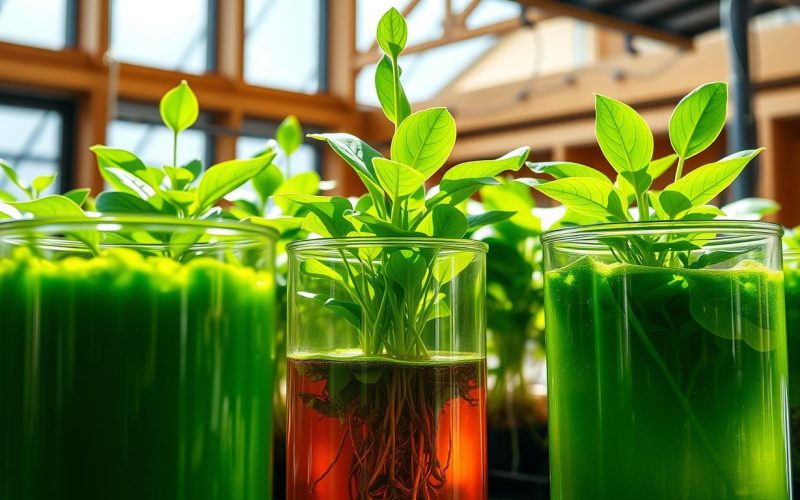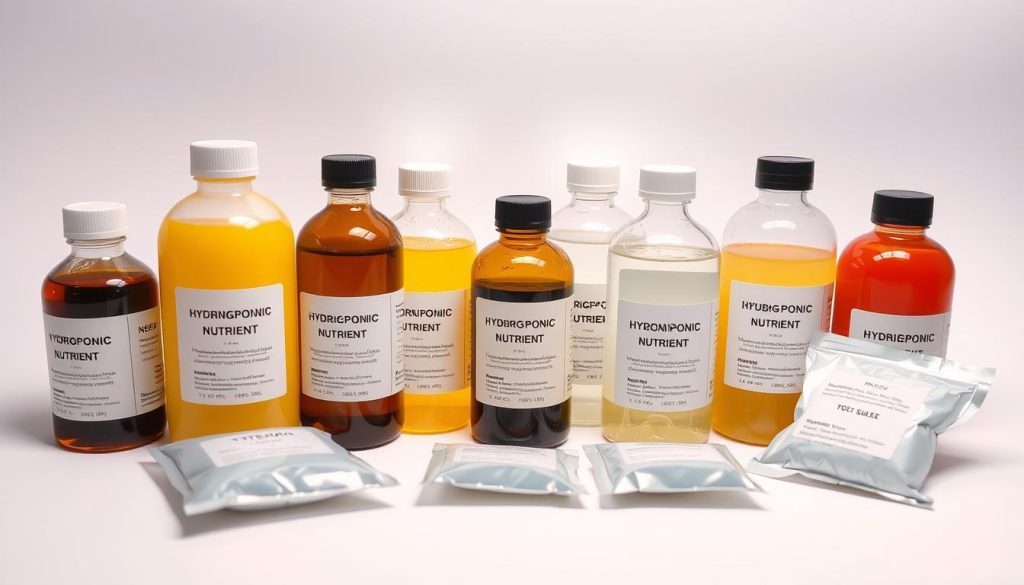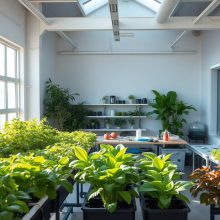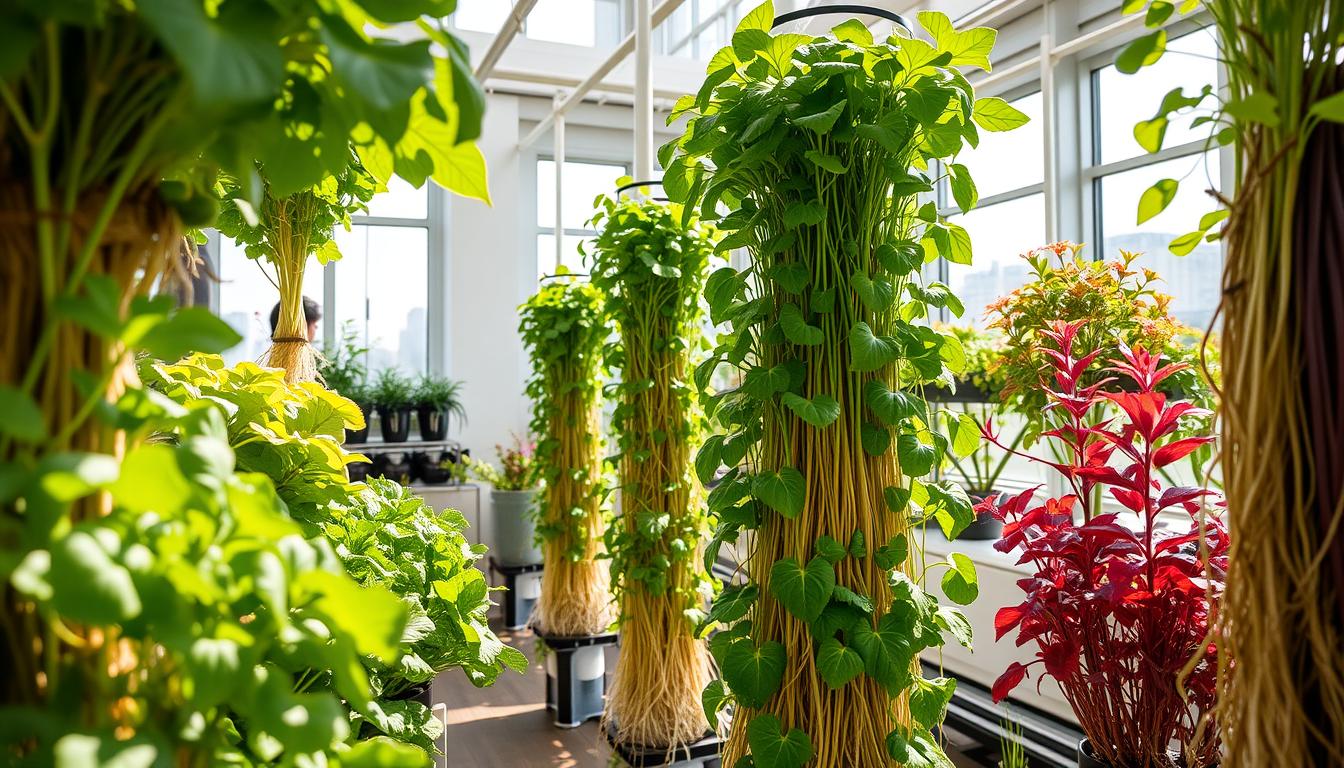Hydroponic Nutrients: The Key to Thriving Indoor Plants

Indoor gardening has changed how we grow plants with hydroponics. Hydroponic nutrients are vital for plants that don’t use soil. They give plants the minerals they need right to their roots.
This new way of growing plants lets gardeners create the perfect food for them. It helps plants grow faster and stronger than before. By giving plants just the right nutrients, they can grow better than ever.
Growing plants indoors means knowing a lot about nutrients. Hydroponics need careful attention to the right mix of minerals and water quality. To grow plants well indoors, you need to pick the right nutrients and follow the right steps.
Key Takeaways
- Hydroponic nutrients eliminate soil dependency
- Precise mineral delivery accelerates plant growth
- Indoor gardening becomes more controlled and efficient
- Nutrition can be customized for specific plant requirements
- Hydroponic systems reduce water and resource consumption
Understanding Hydroponic Nutrients
Hydroponic gardening is a new way to grow plants. It uses special nutrient solutions instead of soil. These solutions give plants the nutrients they need through water.
What Are Hydroponic Nutrients?
Hydroponic nutrient solutions are special liquids. They have all the minerals and elements plants need to grow. They replace soil’s role in giving plants nutrients, making it a more efficient way to feed plants.
Importance of Nutrient Solutions
Good nutrient solutions are key to hydroponic success. They make sure plants get:
- The right amount of nutrients
- The right mix of minerals
- Nutrients quickly
- Consistent growth
Differences from Soil Nutrients
Soil nutrients and hydroponic solutions are different. In hydroponics, nutrients:
- Are dissolved in water
- Are right away available to roots
- Are controlled and measured
- Are clean, without soil contamination
Knowing these differences helps gardeners grow plants better in hydroponic systems.
Types of Hydroponic Nutrients
Hydroponic gardening needs careful nutrient management for healthy plants. Knowing the different nutrients is key for indoor growing. Nutrient solutions give plants the essential elements they get from soil, vital for hydroponic systems.
Macronutrients: Plant Growth Foundations
Macronutrients are the main parts of plant health in hydroponics. These include:
- Nitrogen (N): Supports leaf and stem growth
- Phosphorus (P): Promotes root development and flowering
- Potassium (K): Enhances overall plant strength
- Calcium: Strengthens cell walls
- Magnesium: Critical for chlorophyll production
Micronutrients: Trace Elements Matter
Micronutrients are needed in small amounts but are crucial for plant growth. Organic nutrients often do well in providing these trace elements, including:
- Iron: Essential for chlorophyll formation
- Manganese: Supports photosynthesis
- Zinc: Helps enzyme production
- Boron: Aids in flower and fruit development
Organic vs. Synthetic Nutrients
Growers can choose between organic and synthetic nutrients. Organic nutrients come from natural sources like fish emulsion or compost. Synthetic nutrients are made to deliver nutrients precisely. Each has its benefits, with organic offering holistic nutrition and synthetic providing exact control.
Choosing depends on your growing goals, plant types, and preferences. Trying different nutrients can help you find the best for your indoor garden.
How Hydroponic Nutrients Work
Hydroponic nutrients are a smart way to feed plants, unlike traditional soil methods. Knowing how nutrient solutions work in hydroponics is key for growing plants indoors.
The success of hydroponic nutrients depends on several important factors. These factors directly affect plant health and growth. They need precise nutrient management for the best results.
The Role of pH Levels
pH levels are crucial for nutrient absorption in hydroponics. Plants do best in a certain pH range for the best nutrient uptake:
- Ideal pH range: 5.4 to 7.0
- Below 5.4: Nutrients become less available
- Above 7.0: Potential nutrient lockout occurs
Nutrient Absorption in Plants
Plant roots in hydroponics take nutrients straight from the water. The nutrient solution must be balanced for efficient uptake. Roots can easily get to essential minerals without soil barriers.
The Impact of Water Quality
Water quality greatly affects hydroponic nutrient performance. Clean, balanced water is essential for plants to get pure nutrition. Things like mineral content, temperature, and contaminants can greatly impact nutrient absorption and plant health.
- Use filtered or reverse osmosis water
- Monitor water temperature (65-75°F is optimal)
- Regular water quality testing is recommended
Understanding these basics helps growers improve their hydroponic nutrient strategies. This leads to better plant growth and yield.
Choosing the Right Nutrient Formula
Finding the right nutrient solution is key for hydroponic gardening success. The right nutrients can mean the difference between healthy plants and a poor harvest. It’s important to match your growing needs and plant requirements with the perfect nutrient formula.
When looking at hydroponic nutrient brands, keep these points in mind:
- Plant type and growth stage
- Nutrient concentration needs
- System design and complexity
- Budget limits
Popular Nutrient Brands to Explore
Top hydroponic nutrient brands offer special formulas for different plants. Companies like General Hydroponics, Fox Farm, and Advanced Nutrients have wide ranges of nutrients. They cater to various growing conditions.
Tailoring Nutrients for Specific Plants
Each crop has its own nutrient needs. Leafy greens like lettuce need different nutrients than fruiting plants like tomatoes or peppers. Getting the right nutrients ensures healthy plants and high yields.
Selection Factors to Evaluate
- Nutrient composition and balance
- System compatibility
- Mixing and application ease
- Performance history
Spending time to research the best hydroponic nutrients is worth it. It leads to healthier plants and more harvests. Always start with small amounts to test before using a full nutrient line.
Nutrient Deficiency Symptoms
Hydroponic plant nutrients are vital for healthy plant growth. Spotting nutrient deficiencies early helps avoid damage to your plants. It ensures they grow well in your hydroponic system.
Common Deficiencies in Hydroponics
Nutrient imbalances can harm plant health. Managing hydroponic fertilizer is crucial. You need to focus on several key nutrients:
- Nitrogen deficiency: Causes yellowing of older leaves
- Phosphorus deficiency: Results in dark green or purplish leaf discoloration
- Potassium deficiency: Produces brown scorching and curling of leaf edges
- Iron deficiency: Creates yellowing between leaf veins
Visual Signs to Watch For
It’s important to understand plant signals in hydroponics. Look out for these signs of nutrient problems:
- Stunted plant growth
- Unusual leaf coloration
- Weak stem structure
- Reduced flowering or fruit production
Solutions for Nutrient Deficiencies
Fixing nutrient deficiencies needs a careful plan. First, check your hydroponic system’s pH levels. Most plants do best between 5.5 and 6.5 pH. Regularly test and adjust your nutrient solution to keep plants healthy.
Act fast to fix problems. Replace your nutrient solution, adjust pH levels, and make sure the environment is right. This will help your plants recover quickly.
Nutrient Solutions Preparation
Preparing hydroponic nutrient solutions needs precision and attention to detail. Growers must know the key steps to make balanced nutrient solutions. This ensures plants grow well and stay healthy.
Mixing Nutrients Properly
Creating the right nutrient solution for hydroponics involves several key steps:
- Start with clean, filtered water at room temperature
- Measure nutrients carefully using a digital scale
- Add concentrated solutions in the correct order
- Stir thoroughly to ensure complete dissolution
The Importance of Clean Equipment
Sterilization is crucial when preparing hydroponic nutrient solutions. Contaminated equipment can introduce harmful bacteria and disrupt nutrient balance. Use these cleaning tips:
- Wash mixing containers with mild, unscented soap
- Rinse thoroughly with clean water
- Sanitize equipment with a mild hydrogen peroxide solution
- Dry completely before next use
Storage Tips for Nutrient Solutions
Proper storage of hydroponic nutrient solutions extends their effectiveness. Store concentrated nutrients in a cool, dark place away from direct sunlight. Most nutrient solutions remain stable for 3-6 months when stored correctly.
Pro tip: Water testing is essential for maintaining nutrient quality. pH test strips are an affordable solution, with a 15-foot roll costing around $7 and lasting for years. These strips help you monitor and adjust your nutrient solution’s pH levels for optimal plant growth.
Hydroponic Nutrient Schedules
Creating a detailed nutrient schedule is key for hydroponic success. Nutrients are crucial for plant health and growth. A consistent feeding plan is vital for the best results.
To make a good fertilizer schedule, you need to know your plants’ needs. Different plants require different nutrients at different times in their growth.
Importance of a Feeding Schedule
A well-thought-out nutrient schedule makes sure plants get what they need. Important factors include:
- Plant type and variety
- Growth stage development
- Environmental conditions
- System type and setup
Frequency of Nutrient Changes
Changing the nutrient solution regularly is important. It prevents nutrient lockout and mineral buildup. Here are some tips:
- Check nutrient concentration weekly
- Test pH levels every 2-3 weeks
- Replace the full nutrient solution every 1-2 weeks
Adjusting for Plant Growth Stages
As plants grow, their nutrient needs change. Seedlings need less, while flowering plants need more phosphorus and potassium.
Managing hydroponic nutrients well means watching your plants closely. It requires flexibility and regular checks to help them grow well in controlled environments.
Innovative Nutrient Technologies
The world of hydroponic nutrients is changing fast. New technologies are making it easier to feed plants indoors. These advancements are set to change how we grow plants in controlled environments.
Smart Hydroponics: Nutrient Sensors
Advanced sensors are changing how we manage nutrients. These smart systems watch nutrient levels, pH, and plant health in real-time. Now, the best hydroponic nutrients work with these sensors to:
- Automatically detect nutrient imbalances
- Adjust nutrient solutions in real-time
- Send alerts to growers via mobile applications
- Track plant growth and nutrient absorption
Nutrients in Hydrogel Form
Hydrogel-based nutrients are a big step forward. They release nutrients slowly, keeping plants fed consistently. This means growers can control nutrients better with less effort.
Future Trends in Nutrient Solutions
New trends are focusing on sustainability and efficiency. Nanotechnology and bio-based nutrients are becoming popular. They promise better plant absorption and less harm to the environment. These changes could greatly improve nutrient delivery for all hydroponic growers.
Budget-Friendly Nutrient Options
Growing hydroponic plants doesn’t have to be expensive. Smart gardeners can find ways to save money on nutrients. Learning how to do this can help keep costs down while still giving plants the nutrients they need.

Hydroponic nutrients don’t have to be pricey. Knowing where to shop and how to manage nutrients can help. Home gardeners and small growers can save money without hurting their plants’ health.
DIY Nutrient Recipes
Making your own organic hydroponic nutrients can save a lot of money. You can use simple ingredients to make essential nutrients for your plants:
- Compost tea solutions
- Fish emulsion mixtures
- Seaweed-based nutrient blends
- Worm casting liquid fertilizers
Cost-Effective Brands
There are many affordable hydroponic nutrient brands out there. Look for products that offer great value. These are often concentrated and can be diluted for more uses.
Bulk Buying Benefits
Buying nutrients in bulk can save a lot of money. Many makers give discounts for big orders. This means you pay less per unit and use less packaging.
- Reduced price per gallon
- Less frequent purchasing
- Consistent nutrient supply
- Lower shipping costs
With careful planning and smart shopping, hydroponic fans can keep their nutrient costs low. This way, they can still ensure their plants grow well and stay healthy.
The Environmental Impact of Hydroponic Nutrients
Hydroponic plant nutrients are a key to solving big environmental problems in farming. Traditional farming uses a lot of resources, but hydroponics is more eco-friendly. It lets us grow crops with less harm to the planet.
Sustainability Considerations
Modern hydroponic systems cut down on environmental harm in several ways:
- Water conservation: Uses up to 90% less water than traditional agriculture
- Reduced land requirements for crop production
- Minimal soil disruption and erosion prevention
- Lower carbon emissions compared to conventional farming
Reducing Chemical Runoff
Hydroponic nutrient solutions control plant nutrition precisely. This greatly reduces chemical pollution. Closed-loop systems recycle nutrients, stopping them from polluting waterways and ecosystems.
Nutrient Recycling Techniques
Advanced hydroponic systems use new recycling methods:
- Recirculating nutrient management systems
- Biofiltration techniques to purify and reuse nutrient solutions
- Integration with aquaponic systems for waste reduction
These methods show how hydroponic plant nutrients can make farming more eco-friendly. They help balance growing food with protecting the environment.
Nutrient Testing and Adjustments
Keeping nutrient levels right is key for hydroponic gardening success. Watching and tweaking closely can make a big difference. It’s important to make sure plants get the right food to grow well.
Essential Testing Kits for Hydroponic Systems
There are many ways to check on your hydroponic nutrients. Good tools help keep your plants healthy and growing strong.
- Digital pH meters for precise acidity measurements
- Electrical conductivity (EC) testers
- Multi-parameter water quality testing kits
- Digital nutrient concentration analyzers
Recognizing Nutrient Imbalances
Spotting nutrient problems early can save your plants. Looking closely at your plants can tell you a lot about your nutrients.
- Yellowing or discolored leaves
- Stunted growth patterns
- Leaf edge browning or curling
- Unusual leaf texture changes
Best Practices for Nutrient Adjustments
For hydroponic gardening, making small changes to nutrients is best. This helps plants adjust slowly and grow steadily.
- Document all nutrient modifications
- Make changes in small percentages
- Monitor plant response carefully
- Use calibrated equipment for accuracy
Experts in hydroponics know it’s both an art and a science. Regular checks, watching closely, and making small tweaks are the keys to strong plants.
Troubleshooting Common Nutrient Problems
Hydroponic plant nutrients can be tricky to manage. Successful indoor gardening needs careful attention to nutrient balance and system maintenance. Even experienced growers face challenges that can affect plant health and productivity.
Overfeeding vs. Underfeeding Challenges
Finding the right balance of hydroponic nutrients is key for plant growth. Plants show different symptoms when they get too much or too little nutrients:
- Overfeeding signs:
- Leaf burn or discoloration
- Stunted root development
- Nutrient salt buildup
- Underfeeding indicators:
- Pale or yellowing leaves
- Slow growth
- Weak plant structure
Heavy Metal Contamination Risks
Nutrient solutions can sometimes have harmful heavy metals. Regular testing is key to prevent contamination. It’s important to use high-quality hydroponic nutrients and watch water sources closely.
Preventing Clogging in Hydroponic Systems
Clogging is a big challenge for hydroponic systems. Root debris, algae growth, and mineral precipitation can block nutrient pathways. Regular cleaning and using the right filters can help avoid these problems.
- Clean systems weekly
- Use high-quality water filters
- Monitor nutrient solution clarity
- Replace nutrient solutions regularly
Hydroponic Nutrients for Specific Crops
Choosing the right hydroponic nutrients is key for growing crops well. Each plant has its own needs for nutrients to grow and produce well. Knowing what each crop needs helps gardeners create the best growing conditions.
Vegetables and Herbs: Nutrient Precision
Leafy greens and herbs need special nutrients to grow well. Lettuce, spinach, and basil do best with:
- More nitrogen for leaf growth
- A mix of micronutrients
- Lower levels of electrical conductivity
Fruits and Flowering Plants: Advanced Nutrition
Fruiting plants like tomatoes and strawberries need more complex nutrients. They require nutrient solutions that help with flowering and fruiting.
- More phosphorus when they flower
- Rich potassium for fruit growth
- Calcium for strong structures
Specialty Crops in Hydroponics
New hydroponic methods allow for growing unique crops. Microgreens, medicinal herbs, and exotic veggies need special care. Growers must adjust nutrients based on each plant’s needs and growth stage.
Success in hydroponics comes from knowing each crop’s nutrient needs. Trying different nutrients helps gardeners improve plant health and yield.
The Role of Nutrients in Yield Quality
Hydroponic nutrients are key to the quality of plant yields. Growers know that managing nutrients is more than just growing plants. It affects the taste, color, texture, and nutrition of crops.
Top hydroponic nutrients can change how crops look and taste. Studies show that the right nutrients can shape plant traits. This opens up new ways to improve farming.
Flavor and Sensory Characteristics
The type of nutrients affects how plants taste. For example, certain nutrients can make lettuce taste spicier and have curlier leaves:
- Increased blue light exposure produces “spicier” lettuce with curlier textures
- Reduced blue light results in milder, flatter textured produce
- Specific mineral balances can enhance aromatic compounds in herbs
Shelf Life and Nutritional Content
Choosing the right nutrients can make produce last longer and stay nutritious. Growers can adjust nutrient mixes to:
- Increase antioxidant concentrations
- Improve crop preservation capabilities
- Enhance overall nutritional density
Balancing Yield and Quality
Finding the right balance in hydroponic nutrients is crucial. It’s about growing lots of plants and keeping them high quality. By knowing how nutrients work with plants, growers can create perfect growing conditions. This leads to big, healthy harvests.
Transitioning to Hydroponic Nutrients
Switching from traditional soil gardening to hydroponics can be a big change. Hydroponic nutrients offer a precise way to feed plants, unlike traditional gardening.

When you move to hydroponics, knowing how nutrients are delivered is key. Unlike soil, hydroponic fertilizer needs direct solution management and constant checks.
Moving from Soil to Hydroponics
Successful transition involves several key steps:
- Start seeds in potting soil as you normally would
- Carefully rinse roots when transplanting to remove soil residue
- Select appropriate hydroponic nutrients for your specific plant type
- Invest in a reliable pH and nutrient testing kit
Tips for First-Time Hydroponic Growers
New hydroponic gardeners should focus on understanding nutrient balance. Hydroponic nutrients come in two main forms: liquid concentrates and powdered mixes. Start with a balanced, complete nutrient solution for your specific crop type.
Common Mistakes to Avoid
- Overlooking pH levels in nutrient solutions
- Neglecting micronutrient requirements
- Using incorrect nutrient concentrations
- Failing to regularly check and adjust nutrient solutions
Learning to manage hydroponic nutrients takes practice. Start small, be patient, and keep learning about your plants and system needs.
Resources for Hydroponic Nutrient Education
Learning about hydroponic nutrients is a journey that never ends. Growers need to keep learning and find reliable sources. There are many ways to learn, from guidebooks to online forums.
The University of California’s agricultural extension has great resources. Websites like GrowWeedEasy and Hydroponics Secrets have forums for sharing tips. Maximum Yield and Indoor Garden Magazine also have articles on the latest in hydroponics.
Udemy and Coursera now have courses on hydroponics. Places like Urban Farm Online Academy and Nelson Pade University offer certifications. Local extension offices also host workshops with experts.
Being part of professional networks is key. LinkedIn groups for controlled environment agriculture are great for sharing knowledge. Going to conferences and webinars can also give you the latest info.


